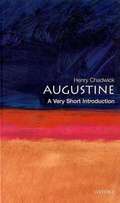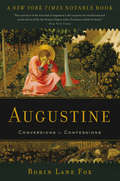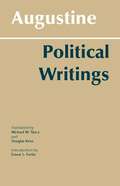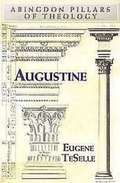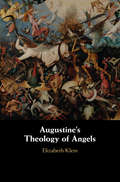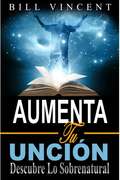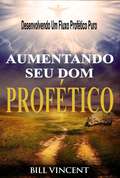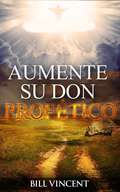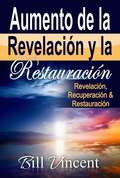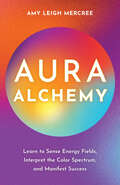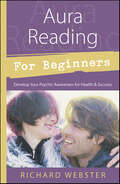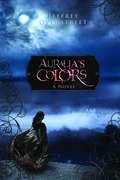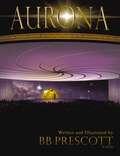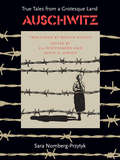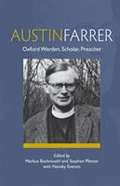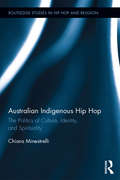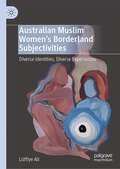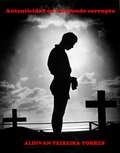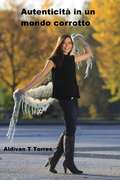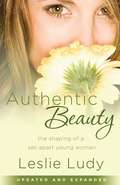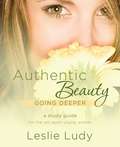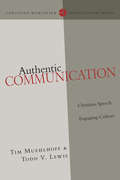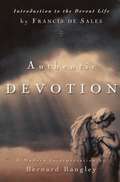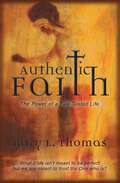- Table View
- List View
Augustine: A Very Short Introduction
by Henry ChadwickAugustine was arguably the greatest early Christian philosopher. His teachings had a profound effect on Medieval scholarship, Renaissance humanism, and the religious controversies of both the Reformation and the Counter-Reformation. Here, Henry Chadwick places Augustine in his philosophical and religious context and traces the history of his influence on Western thought, both within and beyond the Christian tradition. A handy account to one of the greatest religious thinkers, this Very Short Introduction is both a useful guide for the one who seeks to know Augustine and a fine companion for the one who wishes to know him better.
Augustine: Conversions To Confessions
by Robin Lane FoxSaint Augustine is one of the most influential figures in all of Christianity, yet his path to sainthood was by no means assured. Born in AD 354 to a pagan father and a Christian mother, Augustine spent the first thirty years of his life struggling to understand the nature of God and his world. He learned about Christianity as a child but was never baptized, choosing instead to immerse himself in the study of rhetoric, Manicheanism, and then Neoplatonism--all the while indulging in a life of lust and greed. In Augustine, the acclaimed historian Robin Lane Fox re-creates Augustine’s early life with unparalleled insight, showing how Augustine’s quest for knowledge and faith finally brought him to Christianity and a life of celibacy. Augustine’s Confessions, a vivid description of his journey toward conversion and baptism, still serves as a model of spirituality for Christians around the world. Magisterial and beautifully written, Augustine will be the definitive biography of this colossal figure for decades to come.
Augustine: Political Writings
by Augustine Ernest L. Fortin Douglas KriesThe best available introduction to the political thought of Augustine, if not to Christian political thought in general. Included are generous selections from City of God, as well as from many lesser-known writings of Augustine.
Augustine: Self, Context, And Theology In Interpretation (Abingdon Pillars of Theology)
by Eugene TeSelleAbingdon Pillars of Theology is a series for the college and seminary classroom designed to help students grasp the basic and necessary facts, influence, and significance of major theologians. Written by major scholars, these books will outline the context, methodology, organizing principles, method, primary contributions, and major writings of people who have shaped theology as we know it today.For many, all theology subsequent to Augustine is a footnote. He is influential, even today, because of his doctrinal formulations, but even more important, Augustine is a stimulating thinker and constant inquirer. Starting with his philosophical interest in Platonism, which set the framework for his thinking, Eugene TeSelle examines the major themes of Augustine's thought following a more or less chronological order including human fulfillment, evil, creation, the human self, the church and its doctrines, the course of human history, and the relation of Christianity to political matters. Even those who think he was wrong in his conclusions can respect Augustine's willingness to confront problems and think through their implications. "This book on Augustine allows the reader to appreciate how easily one moves from the fourth or fifth century into modern times and back. Eugene TeSelle thus invites the reader to appreciate some of the most significant themes of Augustine’s thought--opening a kind of dialogue between Augustine and other thinkers on topics such as evil and grace, politics and piety, and more." Allan Fitzgerald, O.S.A., Istituto Patristico “Augustinianum,” Rome, Italy "This is an extraordinary book. Eugene TeSelle is one of the great masters of Augustine's thought, and here he draws upon his great erudition to present the father of Western theology cogently and comprehensively for the layperson. The book is at once short and accessible but also profound and thought-provoking; a sensitive treatment of Augustine in his own context, which also makes him wholly relevant for today. TeSelle raises the big questions and provides ample material to begin to answer them." Carol Harrison, Lecturer in the History and Theology of the Latin West, University of Durham, Durham, Great BritainEugene TeSelle is emeritus Oberlin Alumni/ae Professor of Church History and Theology at Vanderbilt University in Nashville, Tennessee.
Augustine: The City of God against the Pagans
by Augustine Of Hippo R. W. DysonThis is the first new rendition for a generation of The City of God, the first major intellectual achievement of Latin Christianity and one of the classic texts of Western civilization. Robert Dyson has produced a complete, accurate, authoritative and fluent translation of De Civitate Dei, edited together with full biographical notes, a concise introduction, bibliography and chronology of Augustine's life. The result is an important contribution of interest to students of theology, philosophy, ecclesiastical history, the history of political thought and late antiquity.
Augustine’s Theology of Angels
by Elizabeth Klein<P>References to the good angels in the works of Augustine are legion, and angels also play a central role in some of his major works, such as City of God and the opening of On the Trinity. Despite Augustine's interest in angels, however, little scholarly work has appeared on the topic. <P>In this book, Elizabeth Klein gives the first comprehensive account of Augustine's theology of the angels and its importance for his thought more generally. Offering a close textual analysis of the reference to angels in Augustine's corpus, the volume explores Augustine's angelology in relationship with his understanding of creation, of community, of salvation history and of spiritual warfare. <P>By examining Augustine's angelology, we glimpse his understanding of time and eternity, as well as the meaning and perfection of created life. Klein's book is foundational for a proper understanding of Augustine's angelology and has far-reaching implications not only for Augustinian studies, but also the broader history of Christian angelology.
Aumenta tu Unción: Descubre lo Sobrenatural
by Bill VincentAumenta Tu Unción por Bill Vincent Descubre lo Sobrenatural Dios dijo que hemos de hacer obras aun mayores. La mayoría de los ministerios ni siquiera están haciendo las obras de Jesús. Dios dijo que hemos de hacer obras aun mayores. La mayoría de los ministerios ni siquiera están haciendo las obras de Jesús. Las cosas están por cambiar. Dios ha hablado y lo que he descubierto se pone a disposición para que todos podamos alcanzar el premio de nuestro llamado de lo alto. Ha llegado el momento para que fluyamos en milagros, señales y prodigios. Digo esto incluso a nivel de la iglesia local. Prepárate para una mayor unción. Recuerda que va a tener un costo para ti, pero valdrá la pena. Estás por descubrir tres tipos de unción que te cambiarán la vida. Se trata de la unción de revelación, la unción que abre cambio y la unción del Rey. Estas son las cosas más importantes que he descubierto que han llevado la unción a un nivel más elevado.
Aumentando Seu Dom Profético: Desenvolvendo Um Fluxo Profético Puro
by Bill VincentSe você é um iniciante ou está no profético já a algum tempo, este livro é para você. Este livro começa com os princípios básicos do ministério profético. Você descobrirá e será encorajado ao ler capítulo após capítulo de “Aumentando Seu Dom Profético”. É hora de todos explorarem seus dons proféticos e terem uma unção ainda mais profunda. No final deste livro, você lerá e será ativado ao ouvir as experiências pessoais de um jovem profeta. Bill começou como um simples pastor e ascendeu para se tornar um poderoso ministro profético. Bill profetizou a muitos e viu centenas de pessoas serem curadas e libertadas através do ministério profético pessoal. É hora de você aumentar seu dom profético hoje.
Aumente su Don Profético
by Bill Vincent Martha MauriSi es principiante o tiene años en lo profético, este libro es para usted. Empezará con los principios básicos del ministerio profético, hará descubrimientos y conforme lea un capítulo tras otro de Aumente Su Regalo Profético se sentirá motivado. Es hora de que todos aprovechen su llamada profética y logre una unción más profunda que nunca. Al finalizar este libro, el escuchar las experiencias personales de un joven profeta le harán sentirse más activado. Bill comenzó como un simple ministro y ahora tiene un poderoso ministerio profético. Bill ha profetizado a muchos y ha visto a cientos sanar y ser liberados a través del ministerio profético personal. Ha llegado el momento de que aumente su don profético hoy.
Aumento de la Revelación y la Restauración: Revelación, Recuperación & Restauración
by Bill VincentEstás por descubrir una porción de lo que toda la Iglesia necesita recibir. Este libro comenzará con el descubrimiento de todo lo que Dios nos ha concedido conocer. Por siglos, el enemigo ha robado y quitado a muchísimas personas. Es momento de aprender cómo hemos de recuperar y experimentar restauración total. Dios quiere despertar la restauración a tal punto que libere un movimiento en el que se restaurará todo lo que se ha perdido o ha sido robado. Recibirás mucha revelación a través de este libro de avance y descubrimiento.
Aura Alchemy: Learn to Sense Energy Fields, Interpret the Color Spectrum, and Manifest Success
by Amy Leigh MercreeDevelop your innate intuition, deepen your connection to the energy flow of the universe, and manifest your heart's desires using the power of your own electromagnetic field by diving deeply into the spiritual science of auras, the colorful energy fields that surround each and every one of us.A fresh take on auras from a medical intuitive who has been working with energy on a quantum level for over twenty years. Take a deep dive into the history and science of auras with this in-depth guide, learning not just what the colors of auras mean and how to see them in yourself and others, but how to raise the frequency of your own aura and those of others and use that knowledge to manifest your best life, filled with harmony and abundance.This books dives profoundly into the truth of complete interconnection in the universe and the living electromagnetic fields around all living things, which we call auras. In essence, the study and awareness of auras is an opening to feel the connection between all life. It also encourages and necessitates opening the clairvoyant and other intuitive senses to feel, taste, smell, touch, see, and hear auras and perceive them in new and expanded ways. These experiences allow the reader to open mind and heart to the universal life force that comprises all existence.
Aura Reading for Beginners: Develop Your Psychic Awareness for Health & Success
by Richard WebsterFully comprehend those around you by learning to read their aura, the energetic manifestation of the soul. Watch for a dirty red haze around those who have just lost their temper, or an expanded aura for those doing philanthropic deeds. Learn to see auras through the proven methods taught by Richard Webster in his psychic training classes, including exploring the chakra system and learning how to restore balance. Then, begin to imprint your desires into your aura to attract what you want in your life.These proven methods for seeing and reading auras will help you:Interpret the meanings of colors in the auraFind a career that is best suited for youRelate better to the people in your lifeEnjoy excellent healthDiscover areas of your life that you need to work onImprint what you want in your future into your auraDiscover the signs of impending ill health, drug abuse, and painChange the state of your aura and stimulate specific chakras through music, crystals, color
Auralia's Colors: A Novel (The Auralia Thread #1)
by Jeffrey OverstreetWhen thieves find an abandoned child lying in a monster's footprint, they have no idea that their wilderness discovery will change the course of history. Cloaked in mystery, Auralia grows up among criminals outside the walls of House Abascar, where vicious beastmen lurk in shadow. There, she discovers an unsettling-and forbidden-talent for crafting colors that enchant all who behold them, including Abascar's hard-hearted king, an exiled wizard, and a prince who keeps dangerous secrets. Auralia's gift opens doors from the palace to the dungeons, setting the stage for violent and miraculous change in the great houses of the Expanse. Auralia's Colors weaves literary fantasy together with poetic prose, a suspenseful plot, adrenaline-rush action, and unpredictable characters sure to enthrall ambitious imaginations.From the Trade Paperback edition.
Aurona
by Bb PrescottWritten with a movie in mind, Aurona is stunningly visual, rich with detailed illustrations and a quickly developing, suspenseful storyline. A technological feast for ages 12 and up, it feeds the universal human quest for the New and Different. Our present space telescopes beg these questions: Is there another planet out there in far better shape than the Earth? Can the atmosphere be in pristine condition with a carefully managed, yet untouched wilderness? Aurona, far more technologically advanced the Earth, offers the possibility that this might actually be possible. A paradise? Utopia? The story unfolds…
Auschwitz
by Sara Nomberg-PrzytykFrom the moment I got to Auschwitz I was completely detached. I disconnected my heart and intellect in an act of self-defense, despair, and hopelessness." With these words Sara Nomberg-Przytyk begins this painful and compelling account of her experiences while imprisoned for two years in the infamous death camp. Writing twenty years after her liberation, she recreates the events of a dark past which, in her own words, would have driven her mad had she tried to relive it sooner. But while she records unimaginable atrocities, she also richly describes the human compassion that stubbornly survived despite the backdrop of camp depersonalization and imminent extermination.Commemorative in spirit and artistic in form, Auschwitz convincingly portrays the paradoxes of human nature in extreme circumstances. With consummate understatement Nomberg-Przytyk describes the behavior of concentration camp inmates as she relentlessly and pitilessly examines her own motives and feelings. In this world unmitigated cruelty coexisted with nobility, rapacity with self-sacrifice, indifference with selfless compassion. This book offers a chilling view of the human drama that existed in Auschwitz.From her portraits of camp personalities, an extraordinary and horrifying profile emerges of Dr. Josef Mengele, whose medical experiments resulted in the slaughter of nearly half a million Jews. Nomberg-Przytyk's job as an attendant in Mengle's hospital allowed her to observe this Angel of Death firsthand and to provide us with the most complete description to date of his monstrous activities.The original Polish manuscript was discovered by Eli Pfefferkorn in 1980 in the Yad Vashem Archive in Jerusalem. Not knowing the fate of the journal's author, Pfefferkorn spent two years searching and finally located Nomberg-Przytyk in Canada. Subsequent interviews revealed the history of the manuscript, the author's background, and brought the journal into perspective.
Austin Farrer: Oxford Warden, Scholar, Preacher
by Marcus Bockmuehl Stephen PlattenAustin Farrer served as Warden of Keble College from 1960 until his sudden death of a heart condition on 29 December 1968. The present volume celebrates his legacy in relation both to the 50th anniversary of his death in late 2018 and to the 150th anniversary of Keble College in 2020.
Australian Indigenous Hip Hop: The Politics of Culture, Identity, and Spirituality (Routledge Studies in Hip Hop and Religion)
by Chiara MinestrelliThis book investigates the discursive and performative strategies employed by Australian Indigenous rappers to make sense of the world and establish a position of authority over their identity and place in society. Focusing on the aesthetics, the language, and the performativity of Hip Hop, this book pays attention to the life stance, the philosophy, and the spiritual beliefs of Australian Indigenous Hip Hop artists as ‘glocal’ producers and consumers. With Hip Hop as its main point of analysis, the author investigates, interrogates, and challenges categories and preconceived ideas about the critical notions of authenticity, ‘Indigenous’ and dominant values, spiritual practices, and political activism. Maintaining the emphasis on the importance of adopting decolonizing research strategies, the author utilises qualitative and ethnographic methods of data collection, such as semi-structured interviews, informal conversations, participant observation, and fieldwork notes. Collaborators and participants shed light on some of the dynamics underlying their musical decisions and their view within discussions on representations of ‘Indigenous identity and politics’. Looking at the Indigenous rappers’ local and global aspirations, this study shows that, by counteracting hegemonic narratives through their unique stories, Indigenous rappers have utilised Hip Hop as an expressive means to empower themselves and their audiences, entertain, and revive their Elders’ culture in ways that are contextual to the society they live in.
Australian Muslim Women’s Borderland Subjectivities: Diverse Identities, Diverse Experiences
by Lütfiye AliThis book claims a discursive space in academic scholarship for knowledges and ways of knowing that capture the diversity, complexity and full humanness of Australian Muslim women’s subjectivities. It draws on in-depth conversational interviews with 20 Australian Muslim women from various ethnic backgrounds during which the women shared their experiences of being at the crossroads of their religious, gendered, racialised and ethnic identities. The book puts forward a decolonial feminist border methodology by weaving the work of decolonial feminist philosophers Maria Lugones and Gloria Anzaldúa with postmodern feminist thinking on subjectivity and with discourse analysis. This methodology is used to centre and attend to the fluidity and plurality of Muslim women’s subjectivities, at the intersections of race, ethnicity, patriarchy, gender, sexuality and Islam.
Autenticidad en un mundo corrupto
by Aldivan Teixeira Torres Karina Gabriela Mangurian FlôrLa historia muestra los valores necesarios para vivir la vida bien y cambiar su realidad. Mediante el asesoramiento perspicaz, puntos a manera de alcanzar el éxito y la felicidad. No se pierda esta oportunidad de cambio.
Autenticità in un mondo corrotto
by Aldivan Teixeira Torres Eleonora MaggiPiccola opera dedicata a coloro che inseguono verità e giustizia, non hanno ancora trovato una direzione nella vita o sono semplicemente curiosi di conoscere una nuova dottrina.
Authentic Beauty
by Leslie LudyInside Every Young Woman is a Princess...In Search of her PrinceIn a culture that mocks our longing for tender romance, in a world where fairy tales never seem to come true -- do we dare hope for more? For every young woman asking that question, this book is an invitation. With refreshing candor and vulnerability, bestselling author Leslie Ludy reveals how, starting today, you can experience the passion and intimacy you long for. You can begin a never-ending love story with your true Prince. Discover the authentic beauty of a life fully set-apart for Him. Experience a romance that will transform every part of your existence and fulfill the deepest longings of your feminine heart.From the Trade Paperback edition.
Authentic Beauty Going Deeper: A Study Guide for the Set-Apart Young Woman
by Leslie LudyExperience the Fulfillment of your Feminine Dreams In a world that mocks our desire for a fairy tale, do we dare long for more? Leslie Ludy offers hope to every young woman who wonders if lasting love can ever be found. In this companion guide toAuthentic Beauty,Leslie gives you the opportunity to talk, write, and think through what it means to find unshakable fulfillment in a daily romance with Christ. Whether you are reading on your own or with a group, this 12-part guide will point you to Jesus Christ - the heroic Prince you have always dreamed of — and enable you to fall in love with Him like never before. Discover what it means to become fully set-apart for Christ, and experience the only true answer to the deepest longings of your feminine heart. From the Trade Paperback edition.
Authentic Communication: Christian Speech Engaging Culture (Christian Worldview Integration Series)
by Todd Lewis Tim Muehlhoffgood
Authentic Devotion: A Modern Interpretation of Introduction to the Devout Life by Francis de Sales
by Francis De SalesCenturies ago, Francis de Sales–bishop of Geneva during the lifetime of many first generation Protestant Calvinists–wrote about the importance of having a spiritual director. Yet he later told his biographer such a person “would be difficult to find,” suggesting that in these circumstances, “We can look for guidance among the books of authors who are no longer living. Devotional books are our best Directors. ” Today, de Sales serves as such a spiritual director to countless modern day believers, and hisIntroduction to the Devout Lifeis recognized as one of the truly great works of devotional literature. Originally written as a series of letters of religious guidance, this enduring book is filled with thoughtful spiritual illustrations and radiates with a warm humanity that touches people of all religious backgrounds. A classic masterpiece of spiritual writing, de Sales’ book is acknowledged to be among the top handful of guides to Christian living. No matter where readers are in their spiritual development–whether they are beginners or skilled theologians–this modern interpretation, an “honest paraphrase” of de Sales’ work,will gently guide them down the clearest path imaginable into a deeper and more authentic religious life.
Authentic Faith: The Power of a Fire-Tested Life
by Gary L. Thomas"This is the victory that has overcome the world, even our faith."--John the Apostle Isn’t it startling how God reveals himself most profoundly in places we least expect to encounter him? He is intent on showing himself Lord in all our circumstances--in the highs and the lows alike. The faith he calls us to is far more than a glowing positivism that shields us from life’s struggles. It is one that guides us into a deepening intimacy with the God who sustains us in the broad sweep of life. Best-selling author Gary Thomas helps us sharpen our spiritual vision and fortify our commitment by examining ten disciplines God uses to forge a fire-tested faith. A biblical view of these disciplines can safeguard us from disillusionment when—not if—difficulties surface in our lives. How we respond will determine the depth and vitality of our walk with God. Sharing scriptural insights, the wisdom of Christians through the centuries, and cogent personal observations, Thomas explores the disciplines of: · Selflessness · Waiting · Suffering · Persecution · Social Mercy · Forgiveness · Mourning · Contentment · Sacrifice · Hope and Fear Drawing liberally from his storehouse of colorful and engaging stories, Thomas brings his topics to life. Find out how a message scrawled on a baseball made a big-league difference to a discouraged young pitcher. Learn how a nineteen-year-old Catholic acolyte, marked by the tragedies of war, grew up to usher in the collapse of Communism in Poland. Read the touching account of feud, reconciliation, and friendship between two of America’s founding fathers. As Gary Thomas reminds us, Jesus said that in this world we will have trouble. Paul exhorted believers to mourn with those who mourn. James wrote that God chooses the poor of this world to be rich in faith. Clearly, faith is about something other than a smooth ride through this fallen world. Rather, authentic faith is shaped, tempered, and purified in the flames of struggle. In a culture sated with blessings and comfort, Authentic Faith reveals the rich benefits that derive from embracing the harder truths of Scripture. This eye-opening look at what it means to be a true disciple of Jesus will encourage you, bolster your faith, and help you rise above shallow attachments to fix your heart on things of eternal worth.
